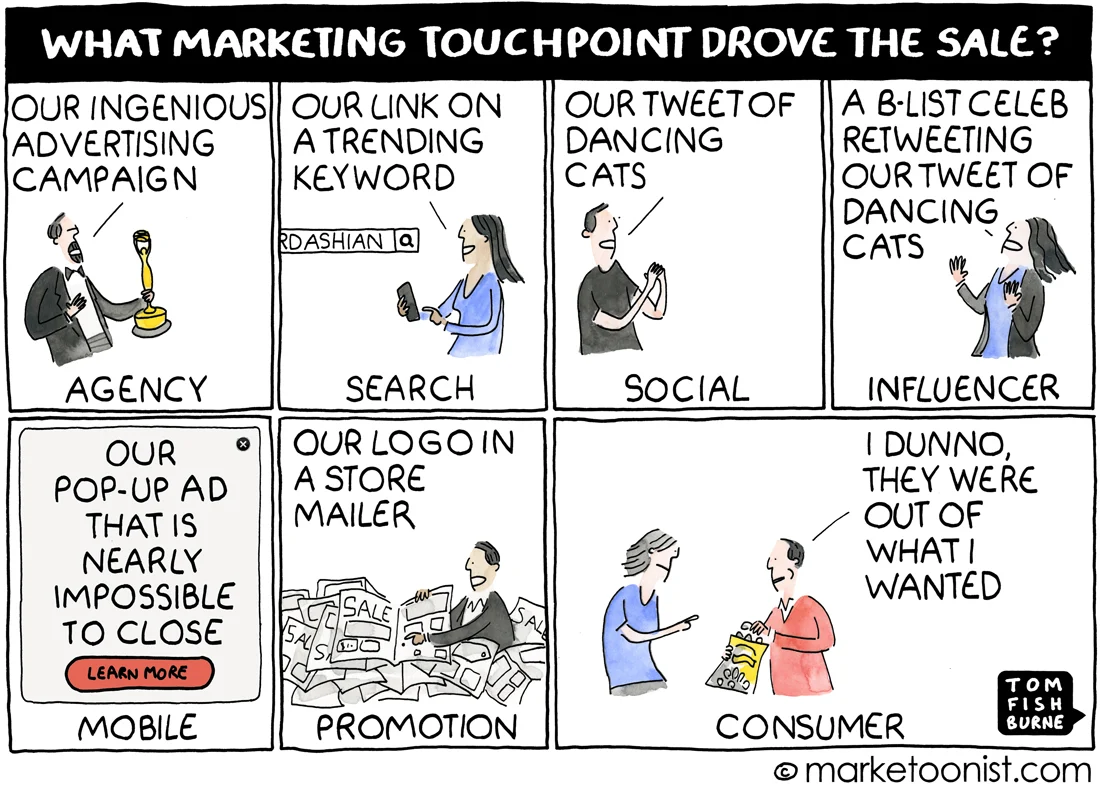Over the last month, I wrote and covered that B2B websites influence just 2.35% of your total addressable market. And the response has been… intense.
Comments and DMs range from marketers defending their budgets to CEOs questioning their spending. And surprisingly, a lot of agreement from people who’ve suspected this for years but couldn’t prove it.
The pushback taught me something important: We’re not having an honest conversation about resource allocation in B2B marketing. We’re defending investments we’ve already made instead of examining whether they make sense.
So let’s have that conversation. With better data. Clearer math. And actionable alternatives.
The Math Nobody Wants to Face
Here’s what triggered the controversy:
- Only 5% of your B2B market is actively buying at any moment (Ehrenberg-Bass Institute/LinkedIn B2B Institute)
- Of that 5%, only 47% consider vendor websites a primary resource (TrustRadius 2023)
- 47% of 5% = 2.35% of your total addressable market
That’s your ceiling. Your absolute best-case scenario for website influence.
Meanwhile, 84% of B2B sales start with a referral (Harvard Business Review). Not your homepage. Not your carefully optimized conversion funnel. A human recommending another human.
The comments revealed four major misconceptions about this reality. Let’s address each with fresh 2024-2025 data.
Misconception 1: “Websites and Referrals Compete for the Same Budget”
The most common pushback: “You’re creating a false choice. We need both websites AND referral programs.”
Nobody’s saying eliminate your website. The issue is proportion.
Average B2B companies allocate 8% of revenue to marketing (Forrester 2024). For a $25M company, that’s $2M. Digital typically consumes half. Yet only 30% of B2B firms have formal referral programs (Influitive/Heinz 2024).
Those that do? They see:
- 71% higher conversion rates from referral leads
- 69% faster close times
- 86% overall revenue growth
- 54% of all leads coming from referrals
The math is straightforward: Referrals generate 54% of leads but get <5% of the budget. Websites that influence 2.35% get 40%+. That’s not balance. That’s misallocation based on what’s measurable rather than what matters.
Misconception 2: “Websites Are Essential for Self-Serve Buyers”
“Modern buyers avoid salespeople,” you argue. “61% prefer rep-free buying (Gartner 2024). The website becomes their salesperson.”
This misunderstands how self-serve actually works in B2B.
Yes, 61% want to avoid sales reps. But they’re not turning to your website for guidance. They’re turning to:
- Coworkers and peers (82% trust most – Forrester 2025)
- Current users (54% talk directly to them – TrustRadius 2023)
- Third-party experts (87% rely on these – Forrester 2025)
- GenAI tools (89% now use for purchasing – Forrester 2024)
Your vendor-driven marketing materials? Only 15% of buyers consult them (TrustRadius 2023).
The self-serve revolution isn’t driving buyers to vendor websites. It’s driving them to peer networks where 91% of decisions are influenced by word-of-mouth (Influitive/Heinz 2024).
Misconception 3: “Complex B2B Requires Sophisticated Digital Infrastructure”
“Enterprise deals need detailed technical documentation,” several CTOs argued. “Buyers need to verify integrations, compliance, and architecture. This requires sophisticated web infrastructure.”
Let’s examine what buyers actually do:
97% check your website before engaging (Wynter 2024). But it’s a scan, not a study. They’re looking for:
- Basic feature confirmation (74%)
- Pricing indicators (68%)
- Customer logos (62%)
- Contact information (58%)
The deep technical verification you’re optimizing for? It happens through:
- Direct conversations with current users (54%)
- Third-party analysis (87%)
- Proof-of-concept trials (43%)
- Reference calls (41%)
Your elaborate technical content hub with gated whitepapers and automated nurture sequences? It’s mostly theatre. Buyers are verifying your claims through channels you don’t control.
Misconception 4: “Digital Investment Builds Long-Term Brand”
“You’re only measuring immediate impact,” marketers countered. “Content builds authority for future buyers (the 95% not currently in-market).”
This assumes the 95% are consuming your content while not buying. They’re not. The average B2B buying cycle is 4.6 months (Gartner 2025). Buyers complete 70% of their journey before contacting vendors. But that journey happens in what 6sense calls “dark funnels” — untrackable channels that represent 70% of the buyer journey:
- Private Slack communities
- WhatsApp groups
- LinkedIn DMs
- Text threads
- Industry dinners
- Internal meetings
Your SEO-optimized blog posts targeting the 95%? They’re publishing into a void. The real brand building happens human-to-human in spaces you’ll never measure.
The Generational Shift That Changes Everything
Here’s what really should terrify traditional B2B marketers: 71% of buyers are now Millennials or Gen Z (Forrester 2024).
These buyers:
- Grew up verifying everything through networks
- Trust peers over institutions by default
- Use GenAI to fact-check vendor claims instantly
- Research in closed communities, not open web
They’ve never trusted vendor content. They never will. Your future buyers are already ignoring your website.
What Actually Works: Evidence From the Field
Companies thriving with minimal web investment share common patterns:
McKinsey & Company: $13B revenue. Website is a recruiting portal and thought leadership library. No product pages. No conversion optimization. Just relationships.
Palantir (pre-IPO): Built $1B+ revenue with a website so minimal journalists complained they couldn’t understand what the company did. Sales: 100% relationship-driven.
Boutique Consultancies: Consistently achieve 70-85% margins with websites unchanged since 2018. Every dollar that could go to digital goes to partner visibility.
The pattern is clear: Relationship-first companies treat websites as infrastructure, not strategy.
The Real Cost of Website Obsession
It’s not just the money, though that’s significant. It’s what you’re not doing while optimizing for 2.35%:
You’re not building referral systems. Only 30% of B2B companies have formal programs, despite referrals driving 54% of leads.
You’re not investing in dark funnel presence. 70% of the buyer journey happens in unmeasurable channels. You have no strategy for this.
You’re not enabling customer advocacy. Your happiest customers want to recommend you. You make it hard.
You’re not tracking actual influence. Your attribution model credits the website for sales that started in WhatsApp groups six months ago.
A Different Path Forward
Stop defending your current allocation. Start testing reality:
1. Audit Your Last 20 Deals
Simple question: “How did you first hear about us?”
Not “what was your last touchpoint?” but “where did this actually start?”
Compare answers to your CRM attribution. The gap is your measurement lie.
2. Run the Referral Math
- Current referral program spend: $_____
- Conversion rate of referral leads vs. others: __%
- Close time of referral leads vs. others: __ days
- ROI of shifting $100k from digital to referrals: $_____
3. Test Your Website Minimum
Cut website optimization budget by 50% for one quarter. Just maintenance. No new features. Track:
- Lead flow
- Conversion rates
- Sales velocity
- Customer feedback
If your website truly drives sales, you’ll see immediate impact. If it’s just processing decisions made elsewhere, you won’t.
4. Map Your Dark Funnel
Post-purchase interviews with 10 recent customers. Ask about:
- Slack conversations that mentioned you
- WhatsApp threads where you came up
- Dinner conversations about vendors
- Internal meetings before they contacted you
That’s where your brand actually lives.
The Uncomfortable Truth
Your website isn’t your revenue engine. It’s a processing center for decisions made in places you can’t see, by people you don’t know, based on conversations you’ll never track.
This isn’t about eliminating websites. It’s about proportional investment based on actual influence, not measurable theatre.
Companies with formal referral programs see 86% revenue growth. Companies optimizing for 2.35% website influence see diminishing returns.
The math has always been clear. We just didn’t want to see it.
Your buyers have already moved on from vendor websites. They’re making decisions in group chats, verifying through peers, and using AI to cut through marketing speak.
The question isn’t whether you need a website. It’s whether you’ll keep burning millions optimizing for yesterday’s buyer while tomorrow’s buyer builds their entire consideration set in channels you’ve never considered.
The 2.35% isn’t changing. Your response to it should.
Data sources: TrustRadius 2023 B2B Buying Disconnect Report, Forrester 2024-2025 B2B Marketing Benchmarks, Gartner 2024-2025 B2B Buying Journey Research, Influitive/Heinz Marketing 2024 B2B Referral Report, 6sense 2025 Buyer Behaviour Report, Wynter 2024 B2B Buyer Journey Research, Ehrenberg-Bass Institute/LinkedIn B2B Institute 95-5 Rule, Harvard Business Review Analytic Services



Leave a Reply
You must be logged in to post a comment.